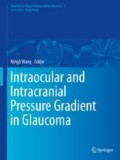Abstract
Glaucoma, which is characterized by loss of retinal ganglion cell death, is a leading cause of irreversible world vision loss. Traditionally, intraocular pressure (IOP) is considered as the main reason that glaucomatous optic neuropathy develops [1]. However, as well as an elevated IOP, a low cerebrospinal fluid pressure (CSFP) has been proved to be another factor that related to the pathogenesis of glaucomatous optic neuropathy, especially in normal-IOP glaucoma patients [2–10]. The trans-lamina cribrosa pressure difference (TLCPD), which is defined as IOP minus CSFP, may be more important for the development of glaucomatous optic neuropathy [3, 5–8, 11–14]. Study on the damage of optic nerve in reduced CSFP animal models has further supported the hypothesis [15, 16]. However, mechanism of reduced CSFP on the optic nerve damage has not been elucidated yet.
Access this chapter
Tax calculation will be finalised at checkout
Purchases are for personal use only
References
Geijssen HC. Studies on normal pressure glaucoma. Amsterdam: Kugler Publications; 1991.
Jonas JB, Berenshtein E, Holbach L. Anatomic relationship between lamina cribrosa, intraocular space, and cerebrospinal fluid space. Invest Ophthalmol Vis Sci. 2003;44:5189–95.
Ren R, Jonas JB, Tian G, et al. Cerebrospinal fluid pressure in glaucoma: a prospective study. Ophthalmology. 2010;117:259–66.
Morgan WH, Chauhan BC, Yu DY, Cringle SJ, Alder VA, House PH. Optic disc movement with variations in intraocular and cerebrospinal fluid pressure. Invest Ophthalmol Vis Sci. 2002;43:3236–42.
Morgan WH, Yu DY, Balaratnasingam C. The role of cerebrospinal fluid pressure in glaucoma pathophysiology: the dark side of the optic disc. J Glaucoma. 2008;17:408–13.
Berdahl JP, Allingham RR, Johnson DH. Cerebrospinal fluid pressure is decreased in primary open-angle glaucoma. Ophthalmology. 2008;115:763–8.
Berdahl JP, Fautsch MP, Stinnett SS, Allingham RR. Intracranial pressure in primary open angle glaucoma, normal tension glaucoma, and ocular hypertension: a case-control study. Invest Ophthalmol Vis Sci. 2008;49:5412–8.
Ren R, Wang N, Zhang X, Cui T, Jonas JB. Trans-lamina cribrosa pressure difference correlated with neuroretinal rim area in glaucoma. Graefes Arch Clin Exp Ophthalmol. 2011;249:1057–63.
Wang N, Xie X, Yang D, et al. Orbital cerebrospinal fluid space in glaucoma: the Beijing intracranial and intraocular pressure (iCOP) study. Ophthalmology. 2012;119:2065–2073.e2061.
Morgan WH, Yu DY, Cooper RL, Alder VA, Cringle SJ, Constable IJ. The influence of cerebrospinal fluid pressure on the lamina cribrosa tissue pressure gradient. Invest Ophthalmol Vis Sci. 1995;36:1163–72.
Yablonski M, Ritch R, Pokorny KS. Effect of decreased intracranial pressure on optic disc. Invest Ophthalmol Vis Sci. 1979;18(Suppl):165.
Jonas JB, Budde WM. Optic cup deepening spatially correlated with optic nerve damage in focal normal-pressure glaucoma. J Glaucoma. 1999;8:227–31.
Morgan WH, Cringle SJ, Balaratnasingam C, Yu DY. Impaired cerebrospinal fluid circulation and its relationship to glaucoma. Clin Exp Ophthalmol. 2008;36:802–3.
Wang N, Xie X, Yang D, Xian J, Li Y, et al. Orbital cerebrospinal fluid space in glaucoma. Ophthalmology. 2012;119:2065–2073.e1.
Yang D, Fu J, Hou R, et al. Optic neuropathy induced by experimentally reduced cerebrospinal fluid pressure in monkeys. Invest Ophthalmol Vis Sci. 2014;55:3067–73.
Zheng Z, Liu D, Jonas JB, Wu S, Kwong JM, Zhang J, Liu Q, Li L, Lu Q, Yang D, Wang J, Wang N. Axonal transport in the rat optic nerve following short-term reduction in cerebrospinal fluid pressure or elevation in intraocular pressure. Invest Ophthalmol Vis Sci. 2015;56:4257–66.
Osborne NN, del Olowns JC, Bellezza A, et al. 3-D histomorphometry of the normal and early glaucomatous monkey optic nerve head: prelaminar neural tissues and cupping. Invest Ophthalmol Vis Sci. 2007;48:5068–84.
Hattar S, Liao H-W, Takao M, Berson DM, Yau K-W. Melanopsin-containing retinal ganglion cells: architecture, projections, and intrinsic photosensitivity. Science. 2002;295(5557):1065–70.
Quigley HA, Brown A, Dorman-Pease ME. Alterations in elastin of the optic nerve head in human and experimental glaucoma. Br J Ophthalmol. 1991;75:552–7.
Author information
Authors and Affiliations
Corresponding author
Editor information
Editors and Affiliations
Rights and permissions
Copyright information
© 2019 Springer Nature Singapore Pte Ltd.
About this chapter
Cite this chapter
Mao, Y., Wang, N. (2019). Biomechanical Mechanisms of IOP-/CSFP-Induced Optic Nerve Damage. In: Wang, N. (eds) Intraocular and Intracranial Pressure Gradient in Glaucoma. Advances in Visual Science and Eye Diseases, vol 1. Springer, Singapore. https://doi.org/10.1007/978-981-13-2137-5_39
Download citation
DOI: https://doi.org/10.1007/978-981-13-2137-5_39
Published:
Publisher Name: Springer, Singapore
Print ISBN: 978-981-13-2136-8
Online ISBN: 978-981-13-2137-5
eBook Packages: MedicineMedicine (R0)

